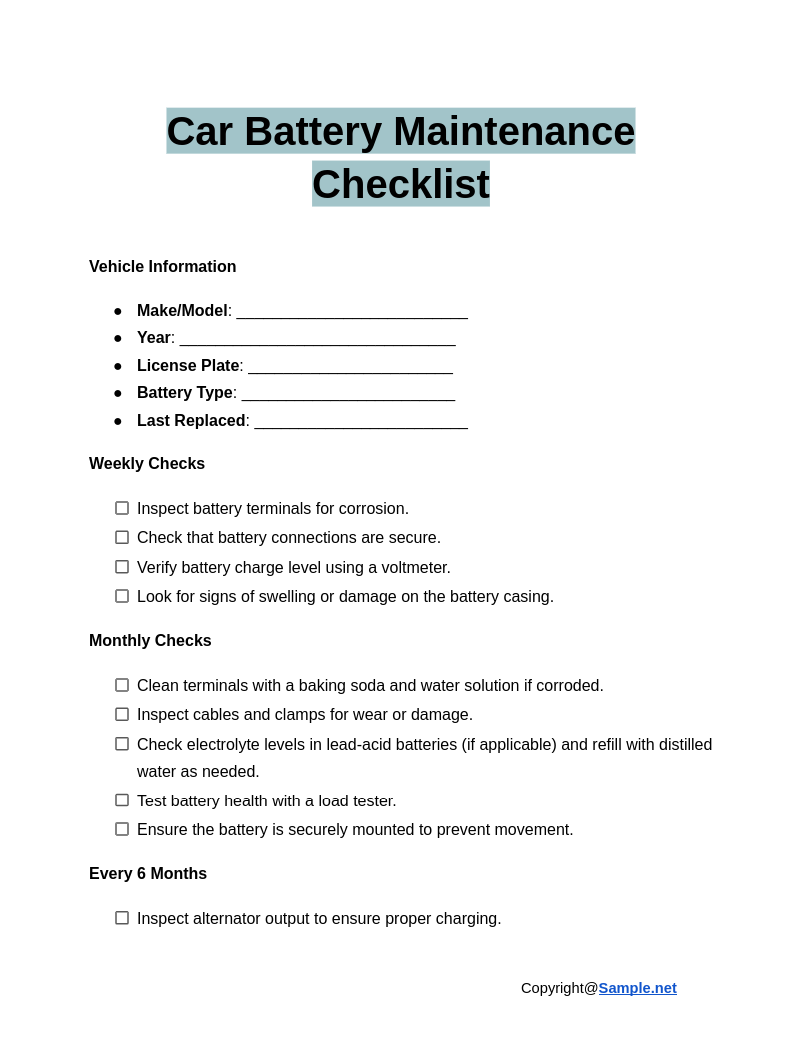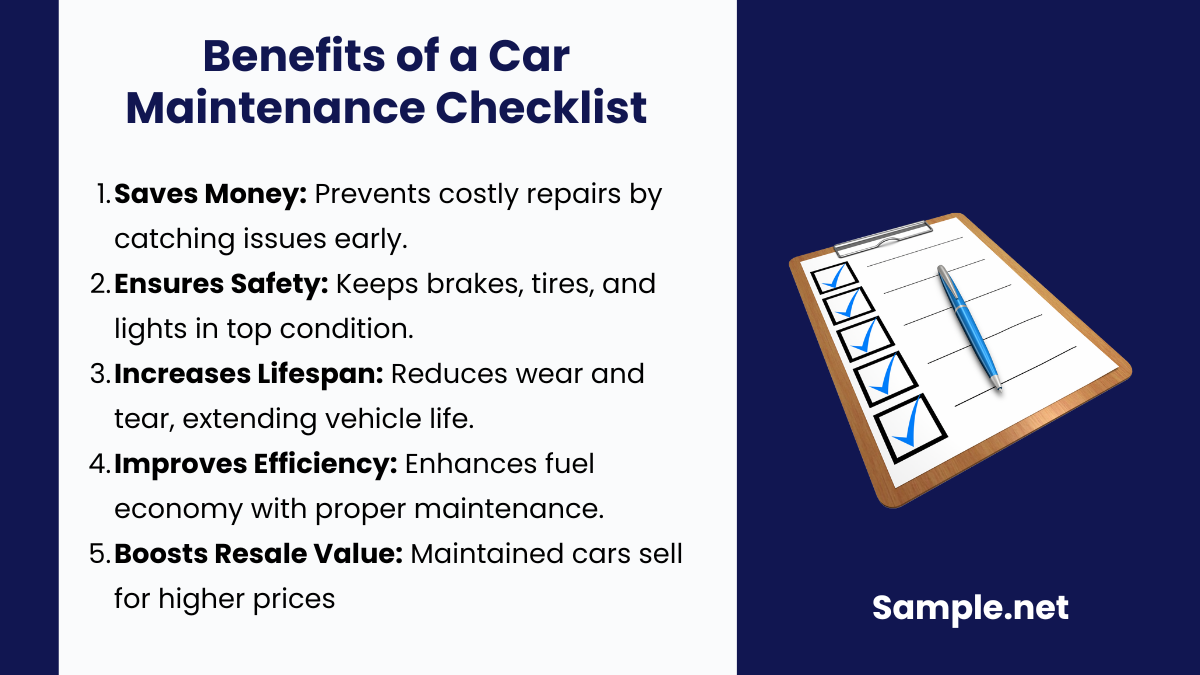Car Maintenance Checklist Samples
-

Daily Car Maintenance Checklist
download now -

Car Battery Maintenance Checklist
download now -

Monthly Car Maintenance Checklist
download now -

Club Car Maintenance Checklist
download now -

Car Maintenance Checklist Template
download now -

Car Maintenance Checklist and Log
download now -

Formal Car Maintenance Checklist
download now -

Road Trip Car Maintenance Checklist
download now -

Car Maintenance Checklist Example
download now -

Car Maintenance Checklist in PDF
download now -

Car Wash Preventive Maintenance Checklist
download now -

Standard Car Maintenance Checklist
download now -

Driver Car Vehicle Maintenance Checklist
download now
FREE Car Maintenance Checklist s to Download
Car Maintenance Checklist Format
Car Maintenance Checklist Samples
What is a Car Maintenance Checklist?
Benefits of a Car Maintenance Checklist
How to Create a Car Maintenance Checklist
FAQs
What happens if you don’t change your oil?
How often should you change your car?
What is the importance of checklist maintenance?
What is a maintenance plan?
What tasks are included in a daily car maintenance checklist?
How can seasonal maintenance checklists improve vehicle performance?
What are the benefits of tracking car maintenance tasks?

Download Car Maintenance Checklist Bundle
Car Maintenance Checklist Format
Vehicle Information
- Make/Model: __________________________
- Year: _______________________________
- License Plate: _______________________
- Mileage: _____________________________
- Date: ________________________________
Daily/Weekly Checks
- Engine oil level
- Coolant level
- Windshield washer fluid
- Tire pressure and condition
- Lights (headlights, brake lights, indicators)
- Wiper blades (check for wear or damage)
Monthly Checks
- Battery terminals and connections
- Brake fluid level
- Transmission fluid (if applicable)
- Belts and hoses (inspect for cracks or wear)
- Exhaust system (check for leaks or damage)
- Check for unusual sounds or vibrations
Every 3,000-5,000 Miles (or as recommended)
- Change engine oil and replace oil filter
- Inspect and rotate tires
- Check air filters (engine and cabin)
- Check spark plugs and ignition system
- Inspect brakes (pads, rotors, and fluid)
- Lubricate moving parts (if applicable)
Every 10,000-15,000 Miles (or as recommended)
- Replace engine air filter
- Flush and replace coolant
- Inspect suspension components
- Check steering system
- Check and replace transmission fluid
Every 30,000 Miles (or as recommended)
- Replace fuel filter
- Service transmission system
- Flush brake fluid
- Inspect and replace spark plugs (if needed)
Seasonal Maintenance
- Spring/Summer
- Check air conditioning system
- Inspect cooling system and radiator
- Inspect tires for summer conditions
- Fall/Winter
- Check heater and defroster
- Replace windshield wiper blades (winter blades, if needed)
- Inspect tires for winter conditions or install snow tires
Emergency Kit Check (Recommended Quarterly)
- Jumper cables
- First-aid kit
- Flashlight with extra batteries
- Emergency blankets
- Spare tire and jack
- Roadside assistance contact details
Service Notes
- Additional Observations:
- Next Scheduled Maintenance: ______________________
What is a Car Maintenance Checklist?
A car maintenance checklist is a structured guide outlining routine checks and services required to keep your vehicle in optimal condition. It includes tasks such as oil changes, tire inspections, brake checks, and fluid level monitoring. This maintenance checklist acts as a preventive measure to avoid costly repairs and ensure safe driving. By following a checklist, car owners can track maintenance tasks effectively, prolonging the life of their vehicles and enhancing their resale value.
Benefits of a Car Maintenance Checklist

1. Prevents Costly Repairs
A well-maintained car is less likely to experience unexpected breakdowns or require costly repairs. Regular checks ensure potential issues are identified early, reducing the risk of major mechanical failures. For example, replacing a worn-out timing belt on time can prevent expensive engine damage. The checklist serves as a proactive tool, keeping you ahead of potential problems. By investing time in routine maintenance, you save significant money in the long run.
2. Enhances Safety
A car maintenance checklist ensures critical safety components like brakes, tires, and lights are in optimal condition. Regular inspections reduce the chances of accidents caused by malfunctions or worn-out parts. For instance, maintaining proper tire pressure and tread depth improves grip, especially in adverse weather conditions. Brakes that function efficiently provide better stopping power, crucial for avoiding collisions. Keeping your car safe not only protects you but also other road users. You can also see more on Preventive Maintenance Checklist.
3. Extends Vehicle Lifespan
Routine maintenance helps extend the life of your vehicle by minimizing wear and tear on its components. Tasks like oil changes and fluid checks keep the engine and other systems running smoothly. A car that receives proper care experiences fewer breakdowns and remains reliable for a longer period. The checklist provides a structured approach to maintaining each part, from the engine to the suspension. This prolongs the car’s usability, delaying the need for a replacement.
4. Improves Fuel Efficiency
A well-maintained vehicle runs more efficiently, consuming less fuel for the same distance. For example, clean air filters and properly inflated tires improve airflow and reduce rolling resistance. Regular engine tune-ups ensure optimal performance, lowering fuel consumption. Poor maintenance, on the other hand, leads to inefficiencies like clogged filters or worn spark plugs that reduce mileage. Using the checklist to stay on top of maintenance tasks can save you money at the pump.
5. Boosts Resale Value
A car with a documented maintenance history attracts higher resale value because it reflects reliability and care. Buyers prefer vehicles that have been consistently maintained, as they are less likely to have hidden issues. By using a checklist, you ensure every aspect of the car is in good condition, from the engine to the exterior. Additionally, a clean service record demonstrates that the car has been regularly inspected and repaired when needed. This makes your vehicle more appealing and commands a better price in the market. You can aslo see more on Room Maintenance Checklist.
How to Create a Car Maintenance Checklist

Step 1: Choose a Document Format
Decide on the format of your checklist document—this could be a simple Word document, a spreadsheet, or a printable PDF. A spreadsheet allows for easier tracking with columns for tasks, dates, and notes. If you prefer a visually appealing option, use a template tool like Canva or Google Docs to create a polished layout. Keep the format simple and user-friendly to ensure it’s practical for regular use. You can also see more on Building Maintenance Checklist.
Step 2: Categorize Maintenance Tasks by Timeframe
Divide the document into sections based on the frequency of tasks: daily, weekly, monthly, seasonal, and annual. Each section should clearly list tasks relevant to its timeframe. For example, under “Daily,” include tasks like checking for fluid leaks or ensuring tire pressure is adequate. For “Annual,” list comprehensive inspections such as brake replacement or engine tune-ups. Organizing tasks by timeframe ensures clarity and easy navigation.
Step 3: Add Specific Checkpoints for Each Task
Detail the tasks under each category, ensuring clarity about what needs to be checked. For instance, instead of just “Check tires,” specify “Inspect tire pressure using a gauge and check for uneven wear.” Use concise and actionable language so users can easily follow the steps. Including instructions or guidelines for each task enhances the utility of the checklist, especially for beginners.
Step 4: Include a Tracking Section
Incorporate a tracking section in your document where users can record the date each task was completed. For example, create columns for the task name, last completion date, and the next due date. This tracking feature helps users stay on top of recurring maintenance. If it’s a physical document, leave space for handwritten notes; for digital templates, provide editable fields. You can also see more on Equipment Maintenance Checklist.
Step 5: Design and Finalize the Template
Enhance the document’s readability by using headers, tables, and icons to organize information visually. Add a section for important contacts, like the phone numbers of trusted mechanics or service centers. Proofread the checklist for accuracy and clarity before finalizing it. Once completed, save the document as a PDF for easy printing or sharing, ensuring it’s accessible whenever needed.
FAQs
What happens if you don’t change your oil?
When motor oil has not been changed for an extended time, it will begin to gel or solidify, finally transforming into sludge. Oil cannot reach all engine components when this occurs, resulting in starvation in the crankshafts, bearings, camshafts, and other valve train components. You can also see more on Machine Maintenance Checklist.
How often should you change your car?
The average length of license for a vehicle is roughly six years. It makes a difference whether or not your automobile is paid off since if it is, you will be able to deduct its worth from the price of a new vehicle. Calculate the monthly budget and cost of your car, including repairs, fuel, and insurance.
What is the importance of checklist maintenance?
A checklist lists objects that require verification, inspection, or examination. They are utilized in numerous industries, ranging from construction to health care. A preventative maintenance checklist assists in identifying equipment maintenance actions to keep equipment in good condition and increase plant reliability.
What is a maintenance plan?
A maintenance plan includes coverage for routine service (again, according to the manufacturer’s schedule), mechanical problems, and wear and tear. Many maintenance plans are included with purchasing a new vehicle, but they can also be purchased independently.
What tasks are included in a daily car maintenance checklist?
Daily tasks include checking tire pressure, inspecting lights, and looking for fluid leaks. These quick inspections ensure your car is safe and ready for the road. They require minimal effort but provide significant peace of mind.
How can seasonal maintenance checklists improve vehicle performance?
Seasonal checklists prepare your car for extreme weather conditions. For instance, winter maintenance involves checking antifreeze levels, inspecting tires for snow grip, and ensuring the battery is winter-ready. Summer tasks might include AC servicing and coolant checks.
What are the benefits of tracking car maintenance tasks?
Tracking ensures you don’t miss important maintenance deadlines. It provides a detailed record of completed tasks, which helps with resale value and ensures consistent performance over time. You can also see more on Facility Maintenance Checklist.
